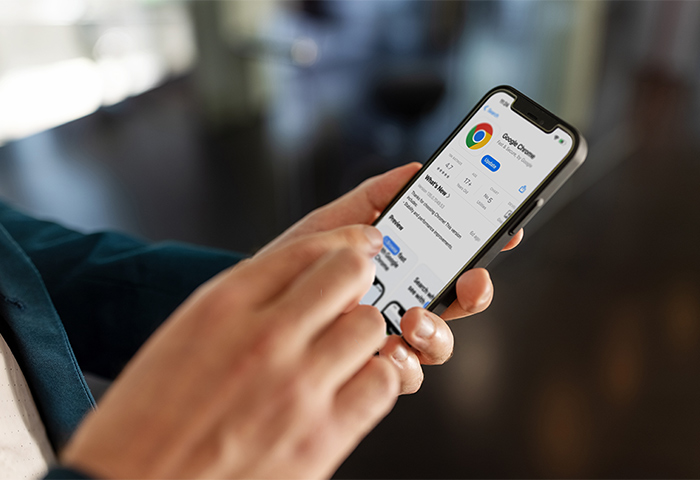What is private browsing?
Private browsing is a feature of most web browsers that keeps your online activity hidden from anyone using the same device. When you use private browsing mode, your browser doesn’t save your search and browsing history, login credentials, or other temporary files on your device, which prevents anyone else who uses your device from accessing that information.
Most major browsers offer privacy modes under various names. If you’ve ever wondered what Incognito mode vs. private browsing means, “Incognito mode” is just Chrome’s name for it. Apple Safari, Opera, and Mozilla Firefox call it “Private browsing,” while Microsoft Edge refers to private browsing mode as “InPrivate.”
How private browsing works
Private browsing works by deleting your browser history and any form data when you close the private window or tab. It also deletes cookies and removes any other temporary data from your browsing session. Most private browsing modes work the same way.
A typical browser logs the sites you visit and search for unless you manually clear your search history. If you don’t disable cookies, browsers save them — which can help save you from having to enter your login details later. But private browsing doesn’t do this, which helps you avoid limited-article paywalls, and even helps prevent some forms of data collection for safer online shopping.
One of the biggest benefits of private browsing is that your activity is hidden from other people using the same device. But using a private window or tab doesn’t hide your IP address or offer safer browsing overall.
How private is private browsing?
The name private browsing can be misleading. Browsing incognito only hides your tracks locally — if someone else uses the same device, they can’t see your private browsing history.
Private browsing does not:
-
Mask your IP address — your physical location and activities are still visible.
-
Conceal your sensitive personal data or let you browse safely on public Wi-Fi.
-
Stop you from being identified and tracked if you log into an online account or profile.
-
Block ad tracking from marketers or other types of trackers that websites use to gather information about you and what you do online.
-
Protect you from cyberattacks, such as malware, viruses, or phishing attacks.
Still, private browsing has its uses and knowing when to browse incognito is part of good digital hygiene.
How to use private browsing
Once you’re in private browsing mode, you can continue browsing the web as normal. But remember, Safari considers individual tabs and windows as separate private browsing sessions, while Firefox, Chrome, and Edge group windows and tabs together.
Here’s how to use a private browsing window in the most common browsers:
Incognito mode in Chrome
Incognito mode deletes your browsing and search history, cookies, and form information. But it does save bookmarks or downloaded files from your session. For extra security as you browse, we recommend installing a Chrome security extension and activating Chrome’s built-in pop-up blocker.
Enter Incognito mode by using the keyboard shortcut Command + Shift + N (macOS) or Ctrl + Shift + N (Windows). Or, here’s how to enable Incognito mode from a browser window:
-
Open Chrome.
-
Click the Menu (three dots) in the top-right corner of your Chrome window and select New Incognito Window.

How to use Chrome Incognito mode on your phone
You can also go incognito on iOS and Android devices. Open your Chrome app, tap the Menu (three dots), and select New Incognito tab.

Private browsing in Safari
Apple’s Safari Private Browsing automatically removes all the temporary files from your sessions, such as your history, form data, and cookies. Safari also lets you allow or disable pop-ups for smoother browsing.
To start a private browsing session, press Command + Shift + N on your keyboard. Or, turn on Safari Private Browsing mode like this:
-
Open Safari.
-
Click File in the top-left corner of your screen and select New Private Window.

How to use Safari private browsing on your phone
You can also enter Safari’s Private Browsing mode on an iOS device. Here’s how:
-
Open Safari.
-
Tap the tabs icon in the right corner on an iPhone or the top-right on an iPad.
-
Tap the button that shows X Tabs (X being the number of open tabs) to see Tab Groups and select Private to start browsing privately.

Secret mode in Samsung Internet
Secret mode is the private browsing mode in Samsung Internet, which comes pre-installed on Samsung phones. Secret Mode has all the usual private browsing features, but also lets you bookmark pages privately so you can return to them the next time you enter a private session.
Here’s how to start Secret mode in Samsung Internet:
-
Open Samsung Internet.
-
Tap the tab icon at the bottom of the screen and choose Turn on Secret mode.

Private browsing in Firefox
Mozilla Firefox’s Private Browsing adds an enhanced feature that blocks hidden trackers by default. You can also block pop-ups in Firefox for a safer browsing experience while using Private Browsing.
Here’s how to start a private browsing session in Firefox:
-
Open Firefox.
-
Click the Menu (three lines) and select New private window.

How to use Firefox private mode browsing on your phone
Here’s how to use Private Browsing on an iOS device:
-
Open the Firefox app and tap the tabs icon at the bottom of the screen.

-
Select the mask icon to switch to Private Browsing.

-
Tap the plus sign (+) to open a new private tab.

To start using Private Browsing in Android:
-
Open the Firefox app and tap the mask icon at the top to switch to Private Browsing.

-
Tap the tabs icon and select +Private to open a new private tab.
InPrivate browsing in Microsoft Edge
Microsoft Edge’s private browsing mode is called InPrivate. While InPrivate browsing erases pages you visit, form data, and search history, it saves downloaded files and bookmarks on your device after you close the window. You can also turn on the pop-up blocker in Edge if pop-ups aren’t already blocked by default in your version of Edge.
To enable Private Browsing in Microsoft Edge, use the keyboard shortcut CTRL + Shift + P to open a new private window. Or, follow the steps below:
-
Open Microsoft Edge.
-
Click the Menu (three dots) in the top-right corner and select New InPrivate window.

How to use Edge private browsing on your phone
Here’s how to open InPrivate mode in Edge on an iOS device:
-
Launch the Microsoft Edge app and tap on the tabs icon.
-
Tap InPrivate to switch to private browsing, then tap the plus sign (+) to open a new private tab.

Here’s how to turn on InPrivate mode on Android:
-
Launch Microsoft Edge.
-
Tap the tabs icon and then tap InPrivate to switch to private browsing.

Private browsing in Opera
Opera's private browsing mode offers the same temporary data features as other modes but adds a built-in VPN connection to provide another layer of protection while browsing. For quick access to private browsing mode, use CTRL + Shift + N (Windows) or Command + Shift + N (macOS).
Here’s how to turn on Opera’s Private Browsing mode:
-
Open Opera.
-
Click Menu (the “O” icon) in the top-left corner. On Macs, click File in the menu bar. Then, select New private window.

How to use Opera private browsing mode on your phone
Here’s how to enable Opera’s private browsing on an iOS device:
-
Open the Opera app.
-
Tap the Menu (three lines) in the bottom-right corner and select Private Mode.

-
Tap the tabs icon to open a new private tab. You’ll see a spy icon in the top right as you browse.

Here’s how to enable private browsing in Opera on an Android device:
-
Open the Opera app, tap the tabs icon, then select Private.

Private browsing in AVG Secure Browser
If you want one of the best browsers for security and privacy, use a private browser like AVG Secure Browser. It includes a private browsing mode, which automatically blocks online tracking and ads, and protects against online threats — like phishing scams and identity theft — with a built-in Web Shield.
Here’s how to activate Private Mode in AVG Secure Browser:
-
Download and install AVG Secure Browser.
-
Click the Menu (three dots) in the top-right corner and select New Private Mode Window.

-
You’ll know you’re in Private Mode when the window turns black and you see the advanced security and privacy features available for Private Mode.

You can start browsing privately immediately by using keyboard shortcuts: CTRL + Shift + N (Windows) and Command + Shift + N (macOS).
Can you really keep your browsing completely private?
Private browsing does not keep your identity anonymous online. Plus, incognito mode won’t protect you from viruses and other threats that could infect your computer or phone. To truly keep things confidential, hide your IP address and keep your internet traffic from being exposed.
A reliable VPN — like AVG Secure VPN — encrypts your internet connection and masks your IP address, so hackers, ISPs, and even your government can’t see what you’re doing online. Privacy is one of the main benefits of a VPN, but it’s also an essential tool for anyone looking to secure their data online — especially if you’re connecting on public Wi-Fi.
But, setting up a VPN alone won’t block ads or protect you from advanced tracking techniques like browser fingerprinting. For that, you’ll need to combine it with a secure browser.
Protect your privacy online with AVG Secure Browser
A secure browser will protect you online from the moment you launch it. AVG Secure Browser provides a suite of features to safeguard your online privacy and secure your personal data.
It automatically blocks ads and advanced browser fingerprinting scripts for anonymous browsing, and includes built-in protection against malware and phishing. Install AVG Secure Browser and get safer, more private browsing today.


































